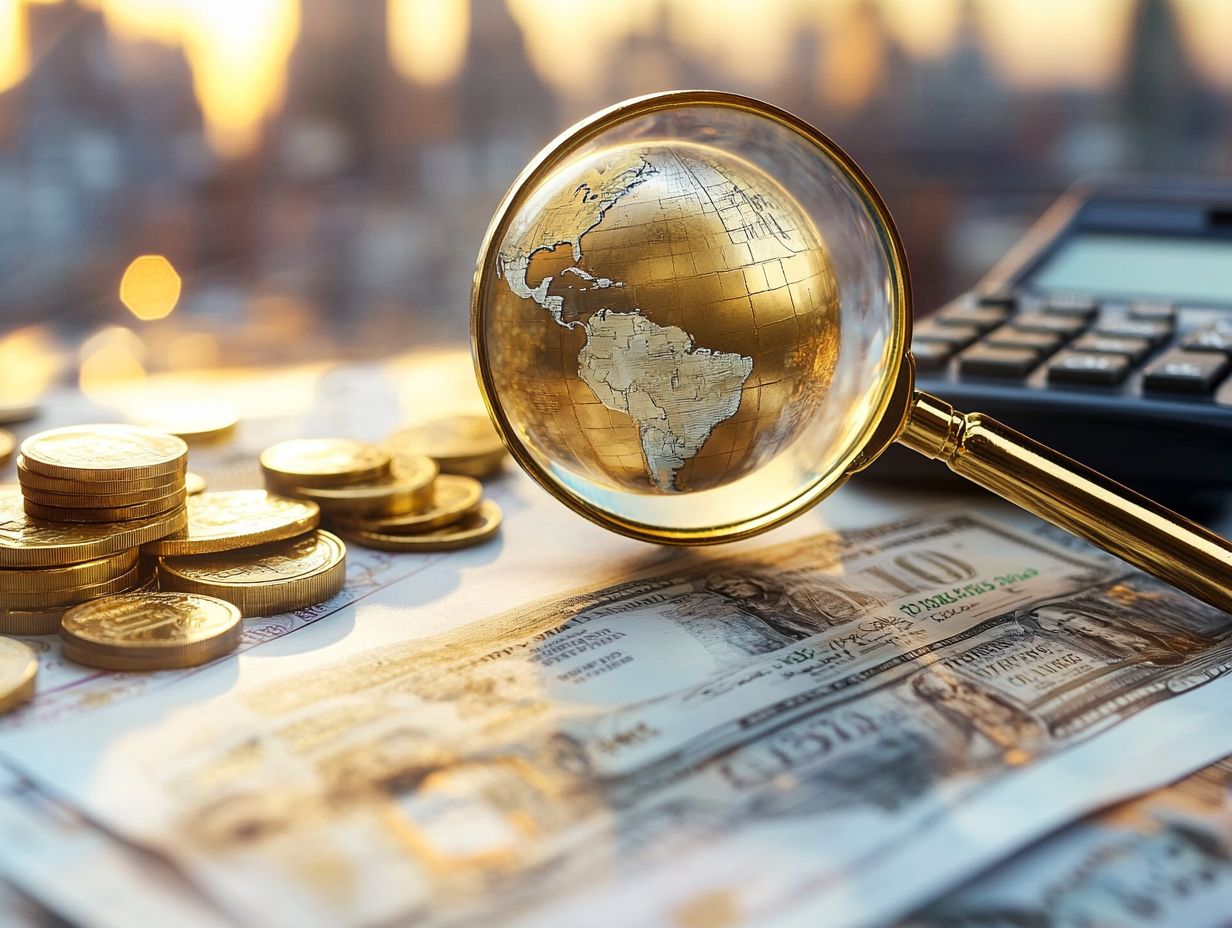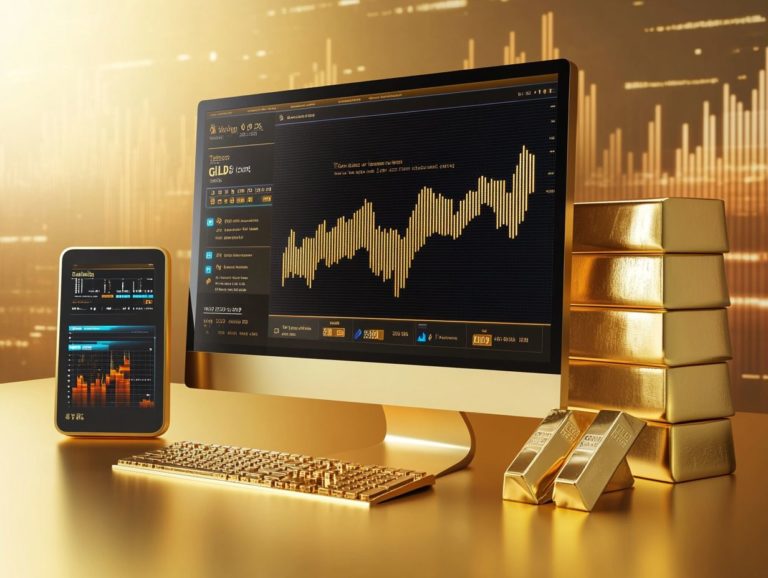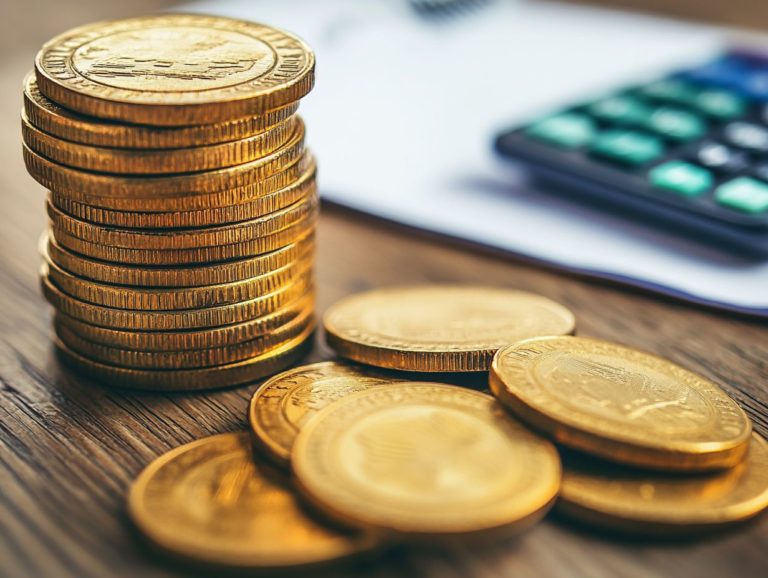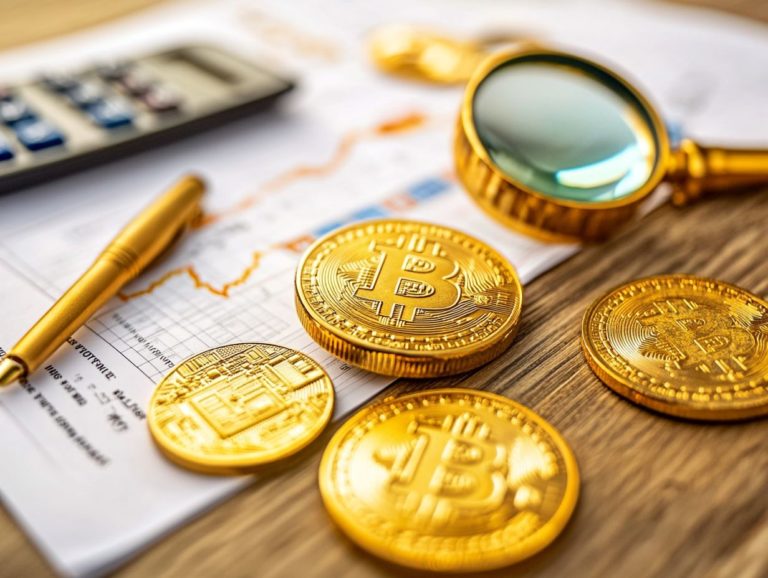5 Considerations for International Gold Investments
Investing in gold presents a distinctive opportunity for you to diversify your portfolio and safeguard against economic uncertainty.
Navigating the realm of international gold investments demands careful thought regarding several key factors. You ll want to grasp current market trends, evaluate political stability, and assess currency exchange rates alongside legal restrictions. Each element is vital to your investment strategy.
Join us as we explore the key factors that can make your gold investments both profitable and secure!
Contents
- Key Takeaways:
- 1. Understand the Current Market Trends
- 2. Research the Political and Economic Stability of the Country
- 3. Consider the Currency Exchange Rates
- 4. Evaluate the Quality and Authenticity of the Gold
- 5. Be Aware of Any Legal Restrictions or Taxes
- How Can Gold Be a Good Investment Option?
- Frequently Asked Questions
- 1. What are the top 5 considerations for international gold investments?
- 2. How can I determine a country’s economic stability for gold investments?
- 3. What role does the currency exchange rate play in international gold investments?
- 4. How does a country’s political climate impact gold investments?
- 5. What are some ways to evaluate gold market trends before making an international investment?
- 6. How important is it to research the reliability of a gold seller before making an international investment?
Key Takeaways:

- Understand market trends to make informed decisions on international gold investments.
- Research the stability of the country before investing in gold to assess potential risks.
- Monitor exchange rates to maximize returns on international gold investments.
1. Understand the Current Market Trends
Understanding current market trends is essential for you as a private investor aiming to navigate the intricacies of gold investment. These trends greatly influence your trading decisions and portfolio strategies, particularly regarding inflation and shifting economic conditions.
By paying attention to how quickly gold can be bought or sold in the market, supply and demand dynamics, and price fluctuations, you can make informed choices that align with your financial security goals and diversification strategies.
As various economic reports emerge, such as employment rates and GDP growth, they offer crucial insights into the economy’s health, which can directly affect gold prices. Geopolitical turmoil, including conflicts and trade tensions, often drives investors like you towards safe-haven assets such as gold, increasing its demand.
Grasping these influences not only helps you predict market movements but also enables you to utilize trading platforms more effectively. This will allow you to seize opportunities and manage risks with confidence. Stay updated on these indicators to seize opportunities in the gold market now!
2. Research the Political and Economic Stability of the Country
Researching the political and economic stability of a country is crucial for you as a private investor considering gold as a long-term investment. Fluctuations in political climates can significantly impact market conditions and the security of your investments.
Take Venezuela and Zimbabwe, for example. Both countries have faced considerable turmoil that resulted in hyperinflation and a sharp decline in trust in local currencies, driving citizens and investors alike to seek refuge in gold as a safe haven. Such scenarios not only erode investor confidence in traditional markets but also elevate the allure of gold reserves, which symbolize a more stable form of wealth.
Nations with stable political environments, like Canada and Switzerland, tend to experience steadier gold prices. Here, investor confidence is supported by economic predictability and strong regulatory frameworks, making gold an even more attractive asset for long-term accumulation.
3. Consider the Currency Exchange Rates
Considering currency exchange rates is crucial for you as a private investor looking to delve into gold investments. Fluctuations in the U.S. dollar and other currencies can significantly impact both the cost of gold and your overall investment returns.
When the dollar weakens, gold typically becomes more appealing to foreign buyers, which drives its price higher. Conversely, a robust dollar can diminish demand and lead to lower gold prices. This dynamic requires you to adopt sharp trading strategies. For example, you might consider hedging against currency risk by creating a diversified portfolio or using gold derivatives.
By understanding the correlation between gold and foreign exchange markets, you can anticipate pricing trends and make well-informed decisions. This will enhance your potential returns while effectively managing the risks tied to currency volatility.
Start your journey in gold investing today! Analyze these factors to secure your financial future.
4. Evaluate the Quality and Authenticity of the Gold

Evaluating the quality and authenticity of gold is absolutely essential for you as a private investor. Doing so ensures that your investments whether in bullion, gold coins, or certificates are reliable. This safeguards both your financial security and the historical value of your assets.
To effectively assess gold quality, consider factors such as purity, which is measured in karats, and the presence of official certification from recognized institutions. These elements collectively signify legitimacy. Purity levels ranging from 10K to 24K can drastically impact both the market worth and investment potential of your gold.
It s crucial for you to make purchases from reputable dealers. This not only guarantees authenticity but also influences the long-term value of your investment. Authentic gold retains its allure and capitalizes on market trends. On the other hand, counterfeit or substandard products can lead to significant financial setbacks for you as an investor.
5. Be Aware of Any Legal Restrictions or Taxes
Being aware of legal restrictions and tax implications is crucial for you as a private investor contemplating gold investments. These factors can significantly impact the profitability and liquidity of your holdings in gold bullion and accounts.
Did you know that ownership laws for gold can change drastically by country? In some jurisdictions, you may enjoy unrestricted private ownership, while in others, strict regulations or even nationalization risks could loom over your investment. Taxation on trading profits also differs widely. For example, capital gains taxes may apply in many Western nations, whereas certain Asian countries might offer exemptions that you can take advantage of.
If you re considering gold loans, it s vital to grasp the local regulatory frameworks governing lending practices and collateral requirements. Familiarizing yourself with these laws is essential. Seeking guidance from financial advisors or legal experts can help you navigate this complex landscape effectively. By doing so, you ll ensure compliance and ultimately maximize your net returns.
How Can Gold Be a Good Investment Option?
Gold emerges as an exceptional investment choice for anyone seeking to build wealth and achieve financial stability. Its historical value, reputation as a safe-haven asset, and prowess in portfolio diversification, especially during inflationary periods, make it truly compelling.
The intrinsic worth and limited supply of gold only enhance its allure. Historically, it has demonstrated resilience, often maintaining or even appreciating in value during economic downturns. This serves as an effective hedge against market volatility. For instance, during the 2008 financial crisis, gold prices surged by nearly 25%, illustrating its remarkable ability to weather economic storms. Financial experts frequently suggest allocating a small percentage of your portfolio to this precious metal to help mitigate risks.
Incorporating gold into your investment strategy can serve as a buffer against inflationary pressures, enabling you to protect your purchasing power over time. Don t wait securing your gold investments now could protect your future.
What Are the Different Forms of International Gold Investments?
International gold investments come in various forms, from physical assets like gold bullion and coins to financial instruments such as gold ETFs, futures, and Contracts for Difference (CFDs). Each of these options presents its unique advantages and risks, tailored for the discerning private investor.
These asset types cater to an array of investment strategies and objectives, making them suitable for a diverse group of investors. While tangible assets impart a reassuring sense of security and intrinsic value, they also pose challenges related to storage and insurance. In contrast, gold ETFs offer a more liquid alternative, allowing for swift trades without the hassle of physical handling. Futures contracts provide leveraged exposure, but they also bring along greater volatility and risk.
Understanding how these various forms align with your individual liquidity needs and diversification strategies is crucial for making informed investment decisions.
What Are the Potential Risks and Benefits of Investing in Gold?

Investing in gold brings a distinct blend of risks and rewards. Don t overlook market volatility it’s vital for your investment! Consider inflation protection and its reputation as a safe-haven asset as you weigh your options.
In times of economic uncertainty, many find themselves drawn to gold, a metal that has historically preserved its value when inflation strikes. It serves as a dependable hedge, often appreciating when fiat currencies begin to stumble.
However, price fluctuations can present challenges, potentially leading to losses if you re not cautious. To manage these risks, astute investors often diversify their portfolios. Allocating a strategic portion to gold while balancing it with other asset classes can enhance your overall strategy.
By keeping a pulse on market trends and employing dollar-cost averaging, you can maneuver through this ever-evolving landscape with greater confidence. This approach ultimately enhances your financial resilience.
How Can One Diversify Their Gold Investment Portfolio?
Diversifying your gold investment portfolio is essential for minimizing risk and enhancing your overall financial security. Mixing different types of investments helps you create a more resilient strategy.
This approach includes physical gold, such as coins and bars, as well as gold stocks, exchange-traded funds (ETFs), and other commodities. By incorporating these options, you can tailor your investments to align with your specific financial goals and the prevailing market conditions.
For instance, during periods of economic uncertainty, allocating a larger portion to physical gold can serve as a safety net. Meanwhile, investments in gold stocks might offer growth potential in a bullish market. Therefore, assess your risk tolerance and remain agile, making adjustments as market dynamics evolve.
What Are the Factors That Can Affect the Value of Gold?
Several factors can profoundly influence the value of gold, including market conditions, supply and demand dynamics, inflation rates, and critical economic indicators that shape investor sentiment.
Understanding how these elements interact offers invaluable insights for both seasoned traders and novice investors alike. For example, when inflation rates rise something you may have witnessed in recent months gold frequently emerges as a hedge against declining value of money. This often leads to a surge in prices.
Moreover, geopolitical events, such as trade tensions or political instability, can drive demand for gold as a safe-haven asset. Monitoring these variables is essential, as even minor shifts can instigate significant price fluctuations. This allows you to make more informed investment decisions.
How Can One Safely Store and Secure Their Gold Investments?
Safely storing and securing your gold investments is paramount for protecting your assets from theft and loss. You have several options, from bank lockers to specialized gold accounts, all designed to maximize safety.
Each storage option presents its own set of benefits and drawbacks. For example, bank lockers provide a certain level of physical security, but they often come with limited access hours and may charge annual fees. On the other hand, specialized gold accounts offer easy liquidity, though they might involve management fees.
It s essential to have insurance coverage to safeguard against unforeseen events like theft or damage. You should also implement security measures, such as regular audits and keeping clear ownership deeds, to significantly enhance your protection.
This way, you can easily verify your holdings and maintain confidence in your investments.
Frequently Asked Questions

Consider these strategies today to secure your financial future with gold!
1. What are the top 5 considerations for international gold investments?
The top 5 considerations for international gold investments include:
- Analyzing the country’s economic stability.
- Understanding the currency exchange rate.
- Researching the political climate.
- Looking at gold market trends.
- Determining the reliability of the gold seller.
2. How can I determine a country’s economic stability for gold investments?
You can determine a country’s economic stability by examining:
- Inflation rates.
- Unemployment rates.
- GDP growth (Gross Domestic Product).
These indicators can provide insight into the country’s overall financial health and its potential impact on the gold market.
3. What role does the currency exchange rate play in international gold investments?
The currency exchange rate significantly impacts international gold investments. A strong currency can result in higher gold prices, while a weak currency may lead to decreased prices.
4. How does a country’s political climate impact gold investments?
The political climate can also affect gold investments. Political instability or unrest can lead to market fluctuations and may influence the value of your investment.
5. What are some ways to evaluate gold market trends before making an international investment?
To evaluate gold market trends, consider:
- Monitoring supply and demand.
- Tracking the performance of major gold mining companies.
- Staying updated on global economic and political events.
6. How important is it to research the reliability of a gold seller before making an international investment?
Researching the reliability of a gold seller is crucial for international gold investments. This action can help you avoid scams or counterfeit purchases.
Make sure to thoroughly check the seller’s reputation, credentials, and customer reviews. Act quickly to secure your safe investment!















